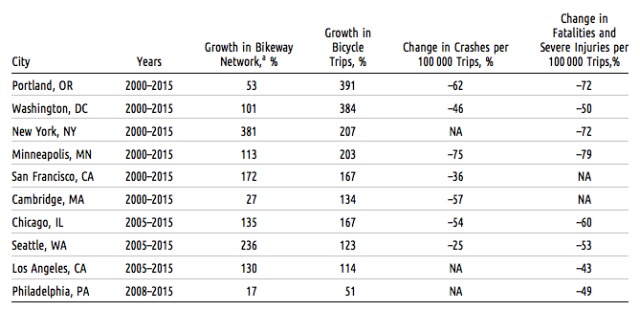America's Cycling Infrastructure Is Pretty Bad, But Chicago Is An Exception That Proves The Rule
By Stephen Gossett in News on May 15, 2017 5:30PM
The United States as a whole remains woefully near the rear of the peloton in terms of bicycling infrastructure—but Chicago is one of a handful of exceptions that proves the rule, according to a new study.
It would seem pretty elementary that as biking infrastructure goes up, that crashes, severe injuries and fatalities would decline. But the dramatic numbers that illustrate that fact, especially here in Chicago, are worth noting. According to the well-timed study (happy National Bike to Week Work, all!), as Chicago's bikeway network grew over the last decade or so (135 percent between 2005 and 2015), crashes per 100,000 trips fell by more than half (54 percent) and fatalities and serious injuries per 100,000 trips dropped 60 percent. And that's as more and more people started bicycling in the city: bicycle trips grew by a whopping 167 percent within those ten formative years. According to the study, which was published in the American Journal of Public Health, other cities that have similarly bulked up their bicycling infrastructure have also witnessed impactful results. Minneapolis for example saw a startling 75 percent decrease in crashes, with even (slightly) less bikeway growth than Chicago.

American Journal of Public Health
The type of infrastructure, rather than just the amount is key, as well, according to researchers: physically separated bike lanes, bollards, and/or concrete barriers are recommended by researcher Ralph Buehler, a professor of urban affairs and planning at Virginia Tech, and John Pucher, a professor in the planning and public policy school of Rutgers University.
"More and better bicycle infrastructure and safer cycling would encourage Americans to make more of their daily trips by bicycle and help raise the current low physical activity levels of the U.S. population," said Buehler in a release.
The Chicago numbers are reassuring for cyclists, if not on the whole surprising. (It wasn't all that long ago, you'll recall, that our city was designated the most bike-friendly in the country.) But as the in-the-works Vision Zero campaign and recent efforts to improve safety at Wicker Park's notorious Milwaukee, Damen and North intersection remind, there's always room to improve. As much as cities like Chicago help improve the U.S.'s overall bike map, we collectively fall far short of countries like Germany, the Netherlands and Denmark, researchers found.
“Traffic fatalities and serious injuries are not inevitable, and they can be reduced by implementing the right policies, especially improved infrastructure and technology,” said Buehler.
And as other research has noted those benefits extend to even include people who never even ride bikes. But given what week it is, and how ground Chicago has gained, it's a good time to do just that.
